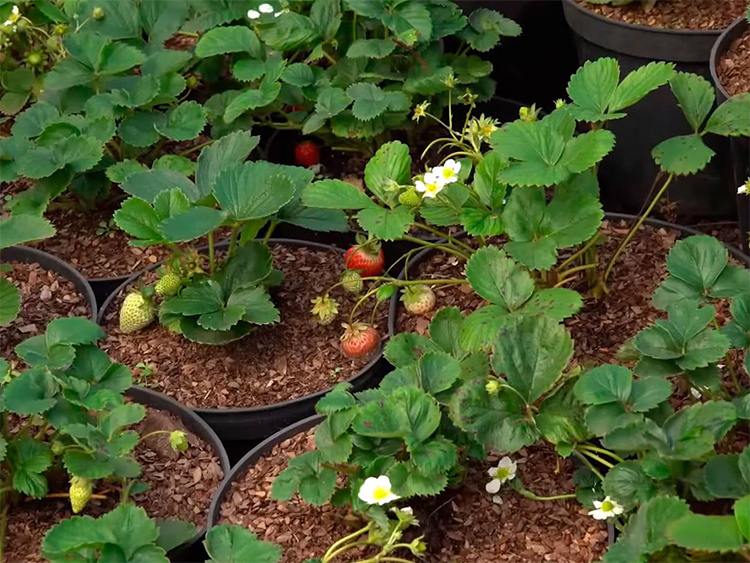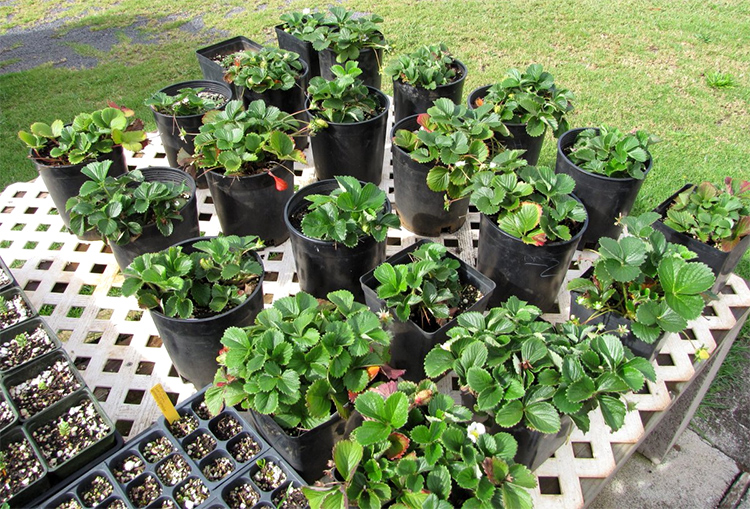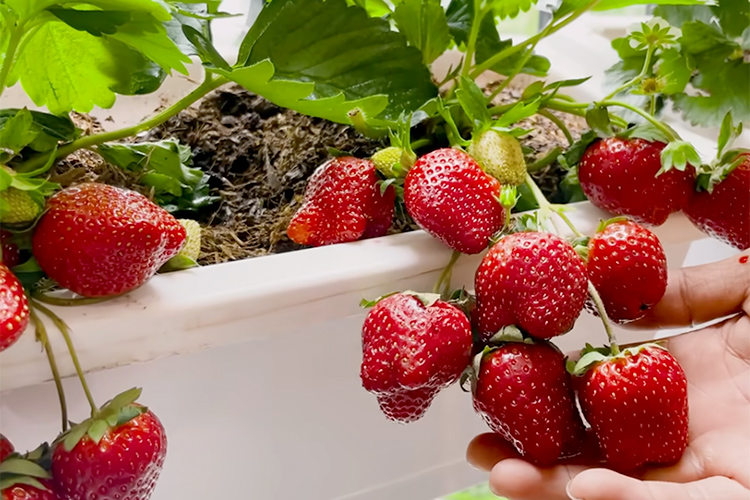We grow strawberries in containers - the advantages and features of this method!

Gardeners, in search of the best solution for their plot, resort to the most non-standard and interesting methods of growing garden strawberries (strawberries), for example, in bags, in pipes, in metal buckets, in old tires, in pots. If there is not enough space on the plot, but you want a variety of plants to grow in your dacha, then you can organize the cultivation of strawberries in plastic boxes, which can be placed both horizontally and vertically. This method is also suitable for growing strawberries at home: a box installed on the floor, on the windows or on the balcony is the easiest way to plant balcony plants.
The difficulty is that plants grow in a limited amount of soil. Accordingly, cultivation and care will have their own key nuances. Below we will answer the most popular questions related to growing strawberries in boxes, tell you how to properly care for the plants, and share useful tips for growing a healthy crop.
Advantages of growing strawberries in plastic boxes
Many experienced gardeners, in order to save space on their land, plant strawberries in plastic boxes, barrels and other containers. Like any other method, growing strawberries in plastic boxes has a number of positive and negative sides. Advantages:
- small boxes are mobile beds, which, due to their small size and weight, can be easily moved to a new location if necessary;
- since the strawberries do not come into contact with the ground, they get sick less;
- saving space: more fruit-bearing plants are placed per square meter; and vertical placement of drawers will allow for the most efficient use of space;
- economical use of materials (small amount of soil in containers, low consumption of irrigation water, tools and fertilizers and plant protection products);
- as a rule, planting in boxes does not require weeding, or seedlings will have to be weeded much less often;
- in autumn, structures can be hidden from the cold in a cellar or barn;
- picking berries is convenient, since you don’t have to bend down to each bush;
- pests that live in the soil (slugs, snails, etc.) cannot reach the plant;
- elements of technology can be used in a garden plot or on the loggia of a city apartment.
The main disadvantages of growing crops in boxes are related to the limited amount of soil. Gardeners note that it is necessary to constantly monitor watering, since the soil dries out quickly and soil moisture is difficult to regulate. High soil fertility is also necessary, which means regular fertilizing.
To obtain a satisfactory result of growing strawberries in boxes, you must carefully prepare and comply with certain requirements.
Selecting drawers
First of all, you need to prepare suitable containers. To grow crops, you can take any boxes with drainage holes, which will help avoid moisture stagnation. First of all, for strawberry plantings you need to choose boxes of the appropriate volume: one plant should contain at least 1.5-2 liters of soil. Holes are required to drain excess moisture. The walls of the container should prevent the soil from drying out too much. For this reason, hanging coconut fiber pots are not suitable for growing strawberries.
The material for making boxes is most often wood. However, wood tends to deteriorate (rot) upon contact with the ground and accumulate pathogenic microorganisms, which is why in the article we will not talk about wooden boxes, but about plastic containers.
Another important point: when choosing boxes, we advise you to pay attention to the color. To ensure that the root system of plants does not suffer from overheating of the soil in the sun, it is advisable to choose a light shade of strawberry boxes.

Depending on the purpose of growing strawberries (own consumption, business, etc.) and the amount of free space, you can place boxes on the site in various ways:
- The easiest way is horizontal: placing individual boxes on the ground. The advantage of the method is much easier access to plants for care and prevention. A person will not have to lift hanging stems growing on the upper tiers or reach for plants located high up. Watering plants in horizontal structures is also more convenient than in vertical ones. The method is also less labor-intensive in terms of arranging the boxes: there is no need to build shelving, construct fasteners, or look for a suitable wall on which to hang or nail the boxes.
- Vertical: you can grow strawberries in boxes on a rigidly fixed base (for example, attached to the walls), hanging or placing the boxes on top of each other. This method allows you to plant a large number of strawberries in a small area, simplifies the care of plantings and harvesting, and, in addition, serves as a decoration for your cottage or garden. Ripening berries hang on long stalks outside the container, do not get lost in the leaf mass or get dirty with soil, and look very beautiful.
- Using plastic boxes of different sizes, you can build pyramids from them.
It is important to place the boxes with strawberries in a sunny area. The fact is that in order to bear fruit, the berry needs to receive direct sunlight for at least 10 hours a day. Northern and heavily shaded balconies, unfortunately, are not suitable, or additional lighting will be required, for example, additional illumination with phytolamps. If the boxes are placed in the shade or damp, the high humidity will increase the likelihood of root rot and disease development. On the site, containers are installed in the most unexpected places: on the lawn, paved area or terrace steps. An additional advantage is that near heated paving stones and stones, plants produce berries faster due to receiving more heat. Experienced summer residents resort to this technique: to prevent the roots from getting too cold in the spring, the boxes can be placed on a layer of hay, straw or leaf humus, then the plants will feel comfortable.
Which varieties of strawberries are best to choose

To get a good harvest of strawberries in a plastic box for a long time, in temperate climates it is recommended to plant only remontant large-fruited and small-fruited varieties and hybrids. This type of garden berry belongs to day-neutral crops. By receiving more heat, the berries will be juicy and tasty throughout the year.
To get a good harvest of berries, it is important to cut off the mustache in a timely manner.
You can grow seedlings yourself from seeds or tendrils, if possible, but it is easier to buy them in a specialized store.
Soil preparation
But the requirements for soil are strict. Since strawberries bear fruit in several stages, the soil should be as fertile as possible, very nutritious, at the same time loose, breathable, well permeable to moisture, but not dry out quickly. Taking into account all factors, a slightly acidic peat substrate enriched with nutrients can be considered the best. To maintain a loose structure throughout the season, it would not be amiss to add one-fifth of the volumetric part of perlite to it.
In order for the berry harvest to pay for all the work of planting and care, you need to take care of preparing the soil mixture. The soil for planting strawberries is prepared following certain rules:
- The bottom needs to be filled with a layer of drainage, for example, expanded clay (25% of the size of the box) is suitable. Instead of expanded clay, many prefer to use crushed bark, large sawdust, crushed stone or small gravel. The point of using a drainage layer is that it improves oxygen access to the roots; without it, the root system will begin to rot. As a result, after mixing you should get a loose, nutritious mixture that conducts water and air well.
- To loosen the soil, coarse sand is added to the soil. Its addition helps improve breathability.
- You should also mix peat, wood ash, compost or rotted manure and add to the soil to increase nutritional value.
Note! For strawberries, you should not use soil on which tomatoes, peppers, potatoes, and cucumbers were previously grown. The best predecessors are herbs, legumes and cereals.
Rules for planting strawberries in boxes
When planting strawberries in boxes, use the one-line method. First, the hole is filled with water, then the seedlings are placed in the planting hole. The roots need to be straightened. The strawberry bushes are buried to the level where the brown underground part of the plant turns into the above-ground green part. Sprinkle dry soil on top and gently press the plant. If this is not done, then there will be no close contact with the ground, this will negatively affect rooting. It’s easy to check whether a plant sits well in the ground: lightly pull the leaves. If the bush does not budge, it means it is planted correctly.
Before planting, the roots of the seedlings are cut, leaving 5 to 7 cm. This technique provokes the rapid development of lateral roots. Do not pour soil up to the very top edge, leave a little space for mulch. The plantings must be watered and mulched again.
Features of caring for strawberries in containers
Despite the apparent simplicity of the method, there is still a lot of hassle in growing seedlings. It is noted that the principles of caring for strawberries planted in plastic containers differ little from the rules of care for the classical planting method. Plantings need to be loosened, the soil watered and fed.
High-quality, strong seedlings with established flower stalks can be taken outside as soon as stable warm weather arrives. On balconies this is possible, as a rule, from the end of April, on the site - from the first ten days of May. If possible, cover with non-woven material at night to protect the plants from night frosts.
To enhance flowering and fruiting, the tendrils that form during the season must be promptly removed. It is also important to remove the first flower stalks of strawberries. This must be done so that the young plants develop well and subsequent harvests are truly abundant.
Watering strawberries in boxes

Great attention should be paid to watering, because the quality of the future harvest directly depends on this procedure. Difficulties may arise due to the fact that the soil in boxes dries out faster than in conventional beds. It should be borne in mind that strawberries react equally poorly to overwatering and too dry soil. The soil should always be moderately moist. If it is not possible to organize drip irrigation, then water should be strictly at the root, avoiding contact with the leaves. Use clean, settled water.
Note. To control the level of soil moisture, many summer residents purchase a special device - a moisture meter.
Sometimes it is effective to combine watering with liquid fertilizing.
Feeding for strawberries
Providing strawberries with the necessary microelements and nutrients is the second important task for obtaining powerful fruit-bearing bushes. Since there is limited space in the boxes, the plants quickly absorb nutrients. Strawberries need to be fed quite often, this is especially important for remontant varieties after the first wave of fruiting.
The addition of nutrients to the soil should be carried out regularly, normally once every 2-3 weeks. Alternate complete mineral fertilizers and organic fertilizers. The approximate fertilizer consumption per plant is 200 ml (one glass). If you can’t calculate the proportions to prepare the fertilizer yourself, then the best option would be to use ready-made fertilizers.
Depending on the chosen variety, plants begin to bear fruit from July to the end of September. On average, you can expect to receive 300-400 grams of berries per bush.
Pollination
As with classical cultivation in open ground, the process of pollinating strawberries in boxes will be carried out by insects, but it is best to purchase self-pollinating varieties that form the berries perfectly even in high heat.
Winter storage
Bushes cannot be stored in boxes in winter. The ground will freeze, which will lead to the death of the root system. Being on the surface of the earth, even covered strawberry bushes will freeze.
To preserve strawberries, you need to either put the strawberries in a safe room for the winter, or in the autumn (approximately September 25-30), the bushes with a lump of earth are removed from the containers and transferred to a regular bed, covered with a layer of straw, spruce branches or covering material in several layers.
If at the end of September small containers with blooming strawberries are brought into a heated greenhouse or onto a balcony (with an air temperature of +15-18 degrees Celsius), then the fruiting period can be extended for another month.
The most daring lovers of gardening experiments try to harvest strawberries in containers on home windowsills or in heated greenhouses in winter. This is a completely feasible task. After all, modern remontant varieties do not require either a period of physiological rest or a period of exposure to low positive temperatures to set flower stalks. The main limiting factors in this case are the lack of light and dry air in closed ground. Providing artificial additional lighting with special lamps, optimal nutrition and watering allows you to get a harvest even in winter.
Growing delicious, aromatic strawberries in containers and boxes is not much different from traditional technologies. But when choosing this option, you should absolutely not allow it to dry out; in this case, there will simply be no harvest. You can grow garden berries not only on an industrial scale. To feed your family delicious berries, you can start small: build a small bed of boxes, fill it with good, fertile soil, plant 10–20 bushes of remontant strawberries, and apply fertilizing. Harvesting fresh sweet berries is only possible if favorable conditions are created, agricultural rules are followed, and the right variety is chosen correctly.